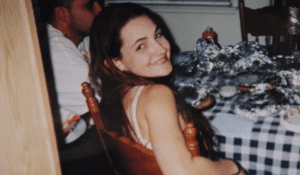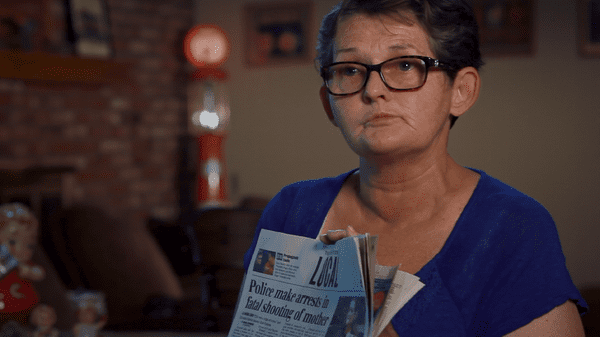Reviewed by Jeffrey Sanzel
catfish (noun)
cat·fish | \ ˈkat-ˌfish \
Definition of catfish
1. any of an order (Siluriformes) of chiefly freshwater stout-bodied scaleless bony fishes having long tactile barbels
2. a person who sets up a false personal profile on a social networking site for fraudulent or deceptive purposes
— Merriam-Webster Dictionary
On February 24, 2006, in Riverside, California, twenty-four-year-old Crystal Theobald was fatally shot in the head while riding in a car with her boyfriend, Juan Patlan, and her brother Justin. (Patlan was hit in the abdomen but recovered.) The case would not be fully resolved until January 2020. The investigation revealed that the attack was due to mistaken identity. The shooter, a member of the gang 5150, mistook the car’s occupants for members of MD, a rival gang.
The driving force behind the Netflix documentary is Crystal’s mother, Belinda Lane, and her vow to find her daughter’s killers. Her use of MySpace to collect information is central to Why Did You Kill Me?
At first, Belinda, who was in the car ahead of her children, identified the shooter from a picture and selects him in a lineup. But it turned out that the boy had a legitimate alibi and was released, making her an unreliable witness. Following this, Lane used MySpace to track down those involved.

Lane’s niece, Jamie McIntyre, began with a fake profile — party girl “Rebecca” — selecting a random photo she found on the internet. At that time, MySpace was relatively new as a social media outlet and quite popular, with sixty-six million users. “My typing was acting,” said McIntyre, who spent every day after school until the early hours of the morning on the site.
Through the Rebecca profile, they connected with various 5051 gang members. Lane decided that McIntyre should build another fake MySpace profile for “Angel,” using Crystal’s photo. Eventually, McIntyre became overwhelmed by the experience. “Making someone fall in love with someone who’s dead is not a good feeling inside.” Pretending to be her every day was a double-edged sword. It kept Crystal’s memory alive and close to her; yet it was a constant reminder of what happened.
When the toll became too much for McIntyre, Lane took over. She created a plan to lure and shoot members of 5150 at “An End of the World Party,” scheduled for June 6, 2006 (6/06/06). “I made a plan to go murder people,” said Lane. But the day before it was to occur, she confronted the driver, William Sotelo, who was infatuated with the non-existent Angel. Lane sent messages beginning with “I know who you are” and “Do you love me?” on to “Then say it,” ending with “then why did you kill me?” Sotelo disappeared and would not resurface for over ten years. Lane gave up the MySpace ruse and released the passwords to the case’s detective, Rick Wheller.
Amid this, the police interrogated William and Manuel Lemus, brothers who had been in the back of Sotelo’s car. They were reluctant to cooperate until members of their gang burned their parents’ home. The pair then turned over the shooter, Julio Heredia. It was not until 2016 that Sotelo, the final perpetrator, was located in Mexico, extradited, tried, and sentenced.
What runs alongside the entire catfishing expedition are revelations about Belinda Lane and her family. Their reluctance to trust Detective Wheeler was rooted in the family’s extensive run-ins with the law. The Lane-Theobold family had “issues back in the day,” including fighting, arrests, and drug issues. Most had been in and out of jail. Belinda admits to being a meth user who became a drug dealer. “I sold a lot. I did a lot of damage out there.”
As she gathered intel through MySpace, Lane did everything she could, including trying to get them deported — calling the FBI and ICE. She contacted members of the Casa Blanca gang, inciting them against 5051. She readily admits that she caused all kinds of violence. As one close friend described her, Belinda was “psycho,” “crazy,” and “insane.” Also, the Lane sons wanted to “handle it their own way.”

Why Did You Kill Me? feels no different than most shows found on the True Crime Network. Ominous music accompanies quick cuts. Sound effects are heightened — including a heart monitor ceasing its beeping, indicating Crystal’s death. Footage of driving to various areas fleshes out the voiceovers. There is a model of the neighborhood where the killing took place, recreated in miniatures. Throughout, various cast members manipulate the cars in the street. Harrowing footage recovered from the security cameras outside a grocery store shows the wounded and dying Crystal in her brother’s arms. Archival family videos and photos are interspersed.
While we get background about the family, we never know who Crystal was. The facts shared are few: she was married and had won $38,000 on a slot machine. The couple used the winnings to open a heating company. At the time of Crystal’s murder, they were estranged, but no other information on their lives is offered, other than her husband had fallen back into drugs. After being mentioned at the outset, her current boyfriend, Juan Patlan, is conspicuously absent from the film.
While we know that the family had its plethora of problems, Crystal’s life and challenges are never addressed.
The gang crises and turf wars are touched upon but also not fully addressed. To give greater depth to the problem and tragic consequences, the creators could have developed this background. No history or explanation is given regarding the origins and presence of the Los Angeles 5150. A nod is given to the investigation into Heredia’s history — revealing drugs, alcohol, and neglect that drove him into gang life. But it does nothing to address the fact that this ruthless, complicated world caused Crystal’s tragic death.
Late in the film, Belinda says, “Justice and revenge. Yes, they are just about the same thing. One means you can stay in the free world, and the other means you can go sit in the defendant’s chair. And that’s a line I almost crossed myself.” Her self-reflection is one of the most powerful moments in the entire documentary.
Lane’s statement contains the kernel of what the film could have been: something valuable, insightful, and cathartic. As it stands, Why Did You Kill Me? is just one in a long line of sensationalist rubbernecking of today’s violence. Should we marvel at the sleuthing? Delight in the internet as a tool? Find entertainment in Belinda’s eccentricity? There is no call to action, no reflection, and no lesson. Sadly, the result is a simple story of a life senselessly ended.
Why Did You Kill Me? is now streaming on Netflix.





